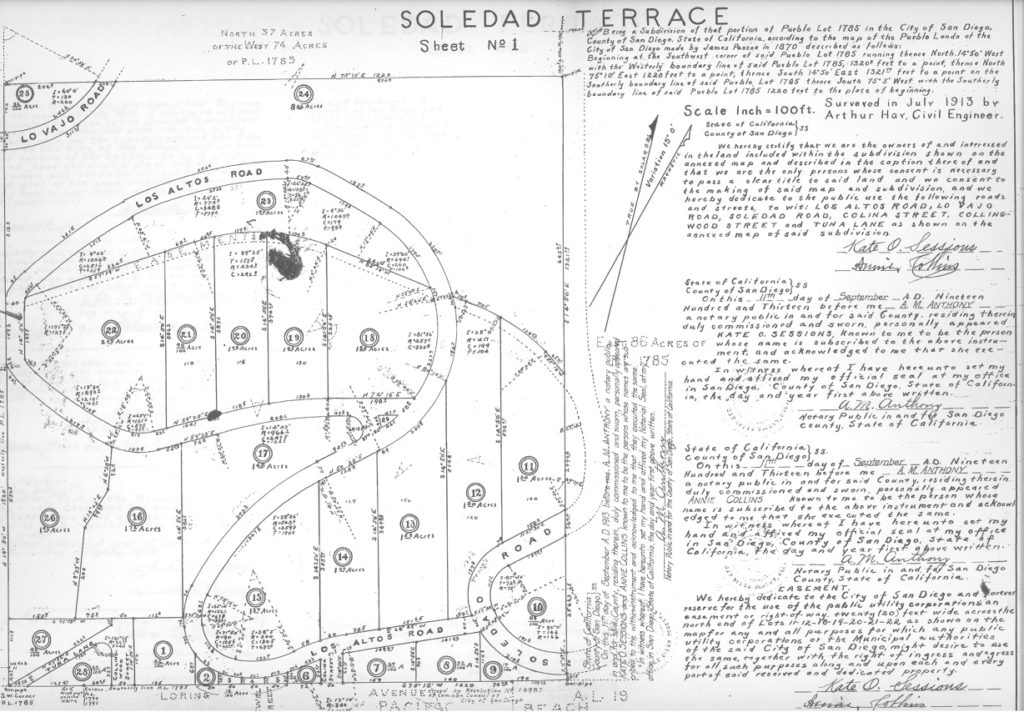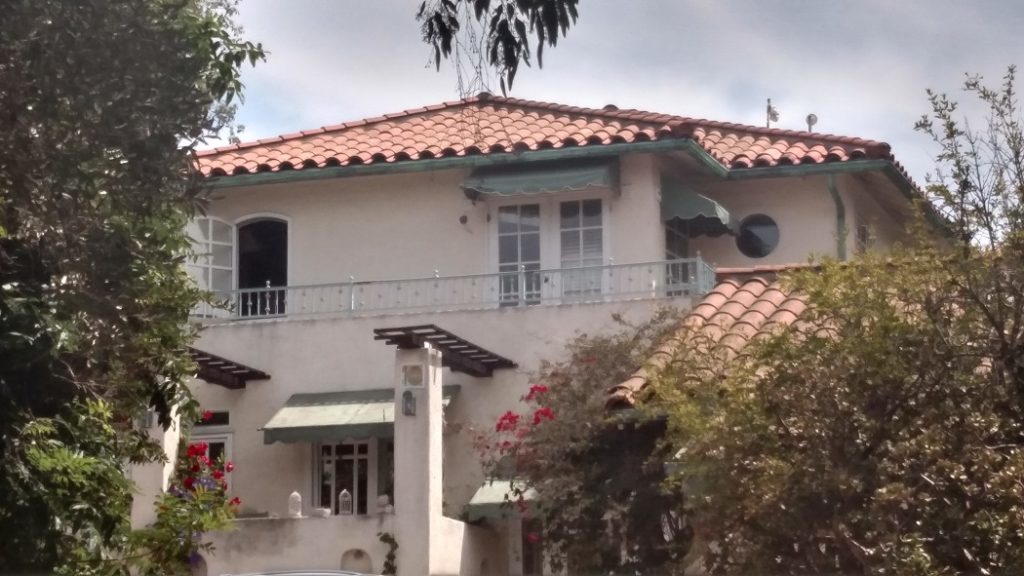Kate Sessions is a legendary figure in San Diego history, best remembered as the ‘Mother of Balboa Park’, which she is credited with transforming from a barren mesa into a landscaped beauty spot and where she is now honored with a bronze statue. Miss Sessions is also honored in Pacific Beach, where a California Registered Historical Landmark at the corner of Garnet Avenue and Pico Street ‘commemorates the life and influence of a woman who envisioned San Diego beautiful’ and explains that she operated a nursery and gained world renown as a horticulturist at that site. A city park overlooking the community and a nearby elementary school are also named in her honor.
In 1892 Kate Sessions had been awarded a 10-year lease on 32 acres of Balboa Park, then called City Park, that required her to plant and maintain 100 ‘choice and varied’ trees in the park and to provide 300 ornamental trees ‘in crocks and boxes’ to the city each year, the trees that transformed the park and eventually shaded many downtown streets. Her lease also allowed her to cultivate and grow additional plants on the site for sale. When her lease in the park and the agreement to provide trees for public spaces came to an end she moved her commercial nursery business to land she had acquired in Mission Hills, then mostly open land in the north of the city. However, Mission Hills was in the path of residential development as San Diego continued to grow and a streetcar line was extended there in 1909. Property values increased and assessments for property taxes also grew. Although Miss Sessions objected, she was unable to obtain relief and she began looking for another area with the climate and soil, and open space, for nursery operations. In 1912 she found what she was looking for in the Mount Soledad foothills above Pacific Beach.
Pueblo Lot 1785 is the half-mile square lying north of Loring Street and east of a northerly projection of Ingraham Street (and the Pacific Beach reservoir site). The eastern 86 acres of Pueblo Lot 1785 had been set apart for the city in 1889, but Miss Sessions and her brother Frank bought the western 74 acres, Frank the northern half and Kate the southern half. Frank Sessions also obtained a 5-year lease on the city’s portion and obtained city permission to install a pumping plant at the adjacent Pacific Beach reservoir to supply a private reservoir he dug at a high point at the northeast corner of his property, near where Soledad Way now meets Soledad Road. He relocated his poinsettia fields from Mission Hills to these lands and by the winter of 1914-15 the San Diego Union reported that the whole hillside was a mass of brilliant red easily discernable from the city.
However, Kate Sessions had other plans for her half of the property in the southwest of the pueblo lot. In 1913 she recorded a subdivision map for Soledad Terrace, dividing the 37-acre parcel into 28 lots connected by Los Altos Road and Soledad Road. Most of these lots were between one and two acres, larger than the typical residential lot but smaller than the acreage lots in the nearby Pacific Beach subdivision. Miss Sessions hoped that lots in her subdivision would appeal to buyers interesting in planting gardens. In April 1915 at least a hundred members of the San Diego Floral Association and other ‘lovers of flowers’ made a ‘pilgrimage’ to Soledad Terrace to inspect the Sessions’ gardens and greenhouses and to hear Miss Sessions’ plans for the development of that section. One of these plans was for completion of Soledad Road to the top of Mount Soledad, and the following April the Floral Association’s visit to Soledad Terrace included a trip by automobile to the top, guided by Miss Sessions, where they celebrated the completion of the road by planting five Torrey pine trees that she donated for the occasion. However, despite the publicity associated with the Floral Association’s annual meetings at Soledad Terrace, Miss Sessions’ real estate venture got off to a slow start. One lot was sold in 1914, another in 1915, and two more in 1916, but sales then stalled until the 1920s and most lots in the central portion of the subdivision remained unsold into the 1930s. The first home in Soledad Terrace was not built until 1926.
Frank Sessions’ five-year lease on the city-owned eastern portion of Pueblo Lot 1785 came to an end in 1917 and he moved on to become superintendent of the city pueblo farm on the mesa between La Jolla and Torrey Pines (where prisoners cut hay and raised vegetables and planted the eucalyptus groves which still stand around the university campus there). His property in the pueblo lot was acquired by Miss Sessions, giving her ownership of the entire western section of the lot. This property included the reservoir that had been used to irrigate the leased land and which she then granted to the city along with an easement for the pipeline supplying it from the Pacific Beach reservoir.
Although she had moved most of her nursery operations to the new growing fields in the Mount Soledad foothills, the Kate Sessions Nursery sales lot remained in Mission Hills into the 1920s and Miss Sessions continued to live in Mission Hills, on Montecito Way, a name she had personally proposed to the City Council. In 1924 she purchased nearly 7 acres of property on Rose Creek in Pacific Beach, property that fronted on Garnet Avenue, then called Grand Avenue and part of the paved highway from San Diego to the north via Pacific Beach and La Jolla (the Pacific Highway through Rose Canyon was not paved until 1930). The nursery sales lot was then moved from Mission Hills to this site, now marked by the historical monument at the corner of Garnet and Pico Street. A tipuana tree that Miss Sessions is supposed to have planted also stands on the site as a ‘living monument’.
In 1927 Miss Sessions herself moved to Pacific Beach, to a ‘two-story cement home’ on lot 22 of Soledad Terrace with a view that ‘could never be obstructed’. In Pacific Beach she was noted for providing inspiration and leadership to community organizations. She frequently addressed the Pacific Beach Woman’s Club and other groups on horticultural topics and was instrumental in founding the Pacific Beach Garden Club. The Floral Association continued to meet annually at her gardens. The Kate Sessions Nursery not only sold plants and trees to retail customers and provided landscaping services to private residences, many of them in Pacific Beach, but also donated plants and landscaping to public institutions such as the new fire station and the school. She was made an honorary member of the ZLAC Rowing Club for her services landscaping their clubhouse on the shore of Mission Bay.
Soledad Road, the extension of Lamont Street that continues to the summit of Mount Soledad, originally climbed the steep slope just north of Loring Street by looping to the west through the Soledad Terrace subdivision before turning north along the boundary between Soledad Terrace and the city land in the eastern part of Pueblo Lot 1785 (although Soledad Road was straightened in 1961, portions of the original loop still exist as Kate Sessions Way and a driveway and storm drain south of today’s Soledad Club). This loop isolated the extreme southwest corner of the city’s property, south and west of the road and east of Soledad Terrace. In 1933 Pacific Beach residents led by Kate Sessions proposed turning this isolated 2-acre section of public property into a city park. Miss Sessions proposed that the little park would be planted with two exotics, blue plumbago and bougainvillea, in addition to native Matilija poppy and two native oak trees (Miss Sessions would donate the exotics and the oak trees). The native shrubs already on the tract would be maintained. The exotic plants would provide color, sky blue and purple, and be visible as a ‘gorgeous splotch’ across the bay. The park would be known as Color Park. Color Park was approved and dedicated in 1935 and the Union reported in 1937 that Boy Scouts under the capable direction of Miss Sessions were at work clearing weeds in the park.
By 1937 Kate Sessions had been a presence in Pacific Beach for 25 years and a full-time resident for 10 years. 1937 was also the 50th anniversary of the founding of Pacific Beach and the chamber of commerce planned a golden jubilee dinner to celebrate the occasion. The president of the chamber announced that Miss Sessions’ devotion to the interests of Pacific Beach through the years and her confidence in its future had earned her the distinction of being the ‘community’s foremost citizen’, and that the jubilee dinner would be held on her 80th birthday and she would be the guest of honor. Over 500 people, including many ‘old-time’ residents, were present as community leaders presented testimonials to her character and achievements.
Kate Sessions died on Easter Sunday, 1940, following a lengthy hospital stay that resulted from falling and breaking her hip while watering plants in her garden. She is buried in Mount Hope Cemetery, where her grave lies along Kate Sessions Avenue under a twisted juniper, her favorite tree. Most of her nursery sales lot on Rose Creek was taken over by the United States government in 1941 for a public housing project but the site is marked by the tipuana tree and the historical monument, dedicated in 1961. Her home in Soledad Terrace is still standing but the large garden lots that once characterized the subdivision have mostly been divided up and filled with large homes, swimming pools and tennis courts. An elementary school built between her former growing fields in the foothills and her nursery site on Rose Creek was named in her honor and opened in January 1956 (I was one of the 499 students who began classes that day).
The city had leased Frank Sessions its property on the eastern side of Pueblo Lot 1785 between 1912 and 1917 and in 1935 had dedicated the 2-acre Color Park in its southwest corner. In 1948 the entire tract became a city park called Soledad Terrace Park. Without Miss Sessions’ supervision the original Color Park had become neglected and was in a state of ruin, according to a 1956 article in the Sentinel, a Pacific Beach weekly. The Sentinel noted that Color Park was the last undertaking of Kate Sessions’ life, and the only one left unaccomplished, and asked what could be more appropriate than to dedicate a revived and completed Kate O. Sessions Color Park on the 100th anniversary of her birth. The city council actually improved on this suggestion and on the 100th anniversary of her birth, November 8, 1957, 79 acres in the eastern part of Pueblo Lot 1785, all of the city land east of Soledad Road, was dedicated as Kate O. Sessions Memorial Park.


